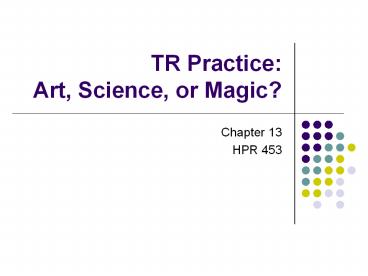TR Practice: Art, Science, or Magic? - PowerPoint PPT Presentation
1 / 15
Title:
TR Practice: Art, Science, or Magic?
Description:
TR Practice: Art, Science, or Magic? Chapter 13 HPR 453 TR: Roots and Now Early Civilization Play and recreation were healing to ill and injured Florence ... – PowerPoint PPT presentation
Number of Views:145
Avg rating:3.0/5.0
Title: TR Practice: Art, Science, or Magic?
1
TR PracticeArt, Science, or Magic?
- Chapter 13
- HPR 453
2
TR Roots and Now
- Early Civilization Play and recreation were
healing to ill and injured - Florence Nightingale arts, music, humor, pets,
writing, conversation in recovery of ill,
injured, and dying soldiers - Recreation contributes to health and QoL
- Art, Science or Magic????
3
TR Practice as Art
- All Recreation is Therapeutic
- CTRS seeks to supplement, alter, or counteract
effects of illness or injury - Introduces media to supplement bodys healing and
health capacity - Encourages individual to be autonomous and seek
meaningful experiences - Results in improvement in health or condition
4
- Based on aesthetics of environment and value of
self-expression and creativity to cause one to
feel good (or at least better) - Arrange interventions in a way to effect sense of
quality or goodness - The participant interprets the value
- Art for arts sake or as recreation as a means
unto itself
5
TR Practice as Science
- TR as the Means to Outcomes or Ends
- More recent phenomenon due to internal and
external forces - Definition of science The observation,
identification, description, experimental
investigation, and theoretical explanation of
phenomena American Heritage Dictionary (1994) - Through research phenomena and theories are
tested and explained
6
- Scientific investigation of TR Practice and
formal training programs began in 1950s - Which interventions were effective?
- What skills do practitioners need to be
effective? - Development of cause and effect and perspective
on importance of constancy of purpose and
consistency of approach
7
Important Developments
- Internally
- Body of knowledge
- professional organizations
- education and training programs
- definition of TR
- observation and investigation of the practice of
TR - accreditation process
8
Practice as a Science Milestones
- Autonomous credentialing program NCTRC
- Based on scientific analysis of TR job functions
and knowledge needed to perform the functions - Born of efforts to provide prof self-regulation
- Educational prerequisites, internship under
qualified professional (CTRS), job knowledge test - 1st real measure of consistency of professional
practice
9
- 1991 National Consensus Conference on Benefits of
TR in Rehabilitation - Temple University and National Institute of
Disability Rehabilitation Research (NIDRR) - Studied efficacy in TR in rehabilitation
- Consistent, uniform Tx outcomes of TR with
specific populations
10
External Developments
- Standardization and accreditation of healthcare
JC, CARF - Regulatory accountability Healthcare Financing
Administration (HCFA) now CMS - Concerns centered on quality delivered
- Costs skyrocketing -gt Insurance industry imposed
restrictions on access to healthcare - Evolution of technology/Consumers access to
information
11
- People living longer, surviving catastrophic
injuries and illnesses and better informed on
options for healthcare - TR exists in scientific arena due to these
factors
12
More recent developments
- Development of evidence-based protocols or
practice guidelines - 2003 ATRA Dementia Practice Guidelines for
Recreational Therapy - Theoretical framework and scientific evidence to
support efficacy of treatment approaches - Pending Guidelines
- Pain, Obesity, Stroke or other neurological events
13
- Important to monitor trends in healthcare for
direction of research and scientific inquiry - Worldwide health initiatives such as WHO ICF
- Move away from disease to health and
health-related domains, how the individual is
impacted by internal body functions and
structures, activity participation, performance,
and functioning in relation to social perspective
and environments impact on functioning Health
and Health Promotion and role of TR
14
TR as Magic
- Holistic or Spiritual Perspective of TR
- Magic defined Possessing distinctive qualities
that produce unaccountable or baffling effects
American Heritage Dictionary (1994) - Some practitioners practice more by doing what
they know works results through power of
charisma, charm, persuasiveness of personality - Mysterious qualities connected to healing
15
- Mind-Body Connection such as acupuncture,
chiropractic, naturopathic medicine, energy-based
modalities such as yoga, Reiki or guided imagery,
autogenics - Used for centuries yet lack scientific evidence
so they are magical - Enter Mind and Behavior If you believe you
can, can you? - Have we as practitioners affected the person by
design, or was it really magic that caused the
change?











![[PDF] Composition Notebook: Goth inspired magic spells and potions | Gothic Cover Composition N PowerPoint PPT Presentation](https://s3.amazonaws.com/images.powershow.com/10055736.th0.jpg?_=202406150112)



















